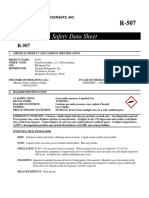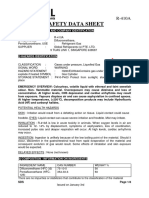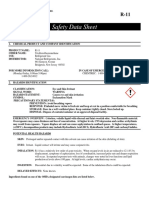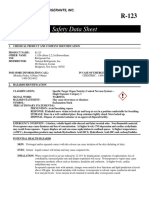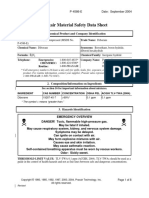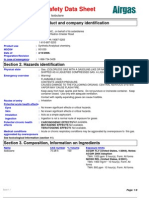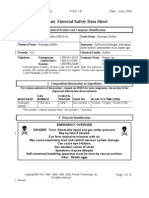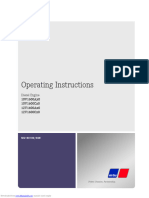Material Safety Data Sheet: Genetron AZ-50 (R-507)
Material Safety Data Sheet: Genetron AZ-50 (R-507)
Uploaded by
freddyCopyright:
Available Formats
Material Safety Data Sheet: Genetron AZ-50 (R-507)
Material Safety Data Sheet: Genetron AZ-50 (R-507)
Uploaded by
freddyOriginal Title
Copyright
Available Formats
Share this document
Did you find this document useful?
Is this content inappropriate?
Copyright:
Available Formats
Material Safety Data Sheet: Genetron AZ-50 (R-507)
Material Safety Data Sheet: Genetron AZ-50 (R-507)
Uploaded by
freddyCopyright:
Available Formats
Material Safety Data Sheet
Genetron AZ-50 (R-507)
1. CHEMICAL PRODUCT AND COMPANY IDENTIFICATION
PRODUCT NAME: Genetron AZ-50 (R-507)
OTHER/GENERIC NAMES: R-125, HFC-125
PRODUCT USE: Refrigerant
MANUFACTURER: Honeywell
101 Columbia Road
Box 1053
Morristown, New Jersey 07962-1053
FOR MORE INFORMATION CALL: IN CASE OF EMERGENCY CALL:
(Monday-Friday, 9:00am-5:00pm) (24 Hours/Day, 7 Days/Week)
1-800-522-8001 1-800-707-4555 or Chemtrec 1-800-424-9300
2. COMPOSITION/INFORMATION ON INGREDIENTS
INGREDIENT NAME CAS NUMBER WEIGHT %
Pentafluoroethane 354-33-6 50
1,1,1-Trifluoroethane 420-46-2 50
Trace impurities and additional material names not listed above may also appear in Section 15 toward the end of the MSDS.
These materials may be listed for local "Right-To-Know" compliance and for other reasons.
3. HAZARDS IDENTIFICATION
EMERGENCY OVERVIEW: Colorless, volatile liquid with ethereal and faint sweetish odor. Non-flammable
material. Overexposure may cause dizziness and loss of concentration. At higher levels, CNS depression and
cardiac arrhythmia may result from exposure. Vapors displace air and can cause asphyxiation in confined
spaces. At higher temperatures, (>250°°C), decomposition products may include Hydrofluoric Acid (HF) and
carbonyl halides
POTENTIAL HEALTH HAZARDS
SKIN: Irritation would result from a defatting action on tissue. Liquid contact could cause frostbite.
EYES: Liquid contact can cause severe irritation and frostbite. Mist may irritate.
INHALATION: Genetron AZ-50 (R-507) is low in acute toxicity in animals. When oxygen levels in air are reduced to
12–14% by displacement, symptoms of asphyxiation, loss of coordination, increased pulse rate and
deeper respiration will occur. At high levels, cardiac arrhythmia may occur.
INGESTION: Ingestion is unlikely because of the low boiling point of the material. Should it occur, discomfort in the
gastrointestinal tract from rapid evaporation of the material and consequent evolution of gas would result.
Some effects of inhalation and skin exposure would be expected.
MSDS Number: GTRN-0003 Page 1 of 7
Current Issue Date: February, 2003
MATERIAL SAFETY DATA SHEET
Genetron AZ-50 (R-507)
DELAYED EFFECTS: None known
Ingredients found on one of the OSHA designated carcinogen lists are listed below.
INGREDIENT NAME NTP STATUS IARC STATUS OSHA LIST
No ingredients listed in this section
4. FIRST AID MEASURES
SKIN: Promptly flush skin with water until all chemical is removed. If there is evidence of frostbite, bathe (do not rub) with
lukewarm (not hot) water. If water is not available, cover with a clean, soft cloth or similar covering. Get medical
attention if symptoms persist.
EYES: Immediately flush eyes with large amounts of water for at least 15 minutes (in case of frostbite water should be
lukewarm, not hot) lifting eyelids occasionally to facilitate irrigation. Get medical attention if symptoms persist.
INHALATION: Immediately remove to fresh air. If breathing has stopped, give artificial respiration. Use oxygen as
required, provided a qualified operator is available. Get medical attention. Do not give epinephrine
(adrenaline).
INGESTION: Ingestion is unlikely because of the physical properties and is not expected to be hazardous. Do not induce
vomiting unless instructed to do so by a physician.
ADVICE TO PHYSICIAN: Because of the possible disturbances of cardiac rhythm, catecholamine drugs, such as
epinephrine, should be used with special caution and only in situations of emergency life
support. Treatment of overexposure should be directed at the control of symptoms and the
clinical conditions.
5. FIRE FIGHTING MEASURES
FLAMMABLE PROPERTIES
FLASH POINT: Gas, not applicable per DOT regulations
FLASH POINT METHOD: Not applicable
AUTOIGNITION TEMPERATURE: >750°C
UPPER FLAME LIMIT (volume % in air): None by ASTM E681
LOWER FLAME LIMIT (volume % in air): None by ASTM E681
FLAME PROPAGATION RATE (solids): Not applicable
OSHA FLAMMABILITY CLASS: Not applicable
EXTINGUISHING MEDIA:
Use any standard agent – choose the one most appropriate for type of surrounding fire (material itself is not flammable)
UNUSUAL FIRE AND EXPLOSION HAZARDS:
Genetron AZ-50 (R-507) is not flammable at ambient temperatures and atmospheric pressure. However, this material will
become combustible when mixed with air under pressure and exposed to strong ignition sources.
Contact with certain reactive metals may result in formation of explosive or exothermic reactions under specific conditions
(e.g. very high temperatures and/or appropriate pressures).
MSDS Number: GTRN-0003 Page 2 of 7
Current Issue Date: February, 2003
MATERIAL SAFETY DATA SHEET
Genetron AZ-50 (R-507)
SPECIAL FIRE FIGHTING PRECAUTIONS/INSTRUCTIONS:
Firefighters should wear self-contained, NIOSH-approved breathing apparatus for protection against possible toxic
decomposition products. Proper eye and skin protection should be provided. Use water spray to keep fire-exposed
containers cool.
6. ACCIDENTAL RELEASE MEASURES
IN CASE OF SPILL OR OTHER RELEASE: (Always wear recommended personal protective equipment.)
Evacuate unprotected personnel. Protected personnel should remove ignition sources and shut off leak, if without risk, and
provide ventilation. Unprotected personnel should not return until air has been tested and determined safe, including low-
lying areas.
Spills and releases may have to be reported to Federal and/or local authorities. See Section 15 regarding reporting
requirements.
7. HANDLING AND STORAGE
NORMAL HANDLING: (Always wear recommended personal protective equipment.)
Avoid breathing vapors and liquid contact with eyes, skin or clothing. Do not puncture or drop cylinders, expose them to
open flame or excessive heat. Use authorized cylinders only. Follow standard safety precautions for handling and use of
compressed gas cylinders.
Genetron AZ-50 (R-507) should not be mixed with air above atmospheric pressure for leak testing or any other purpose.
STORAGE RECOMMENDATIONS:
Store in a cool, well-ventilated area of low fire risk and out of direct sunlight. Protect cylinder and its fittings from physical
damage. Storage in subsurface locations should be avoided. Close valve tightly after use and when empty.
8. EXPOSURE CONTROLS/PERSONAL PROTECTION
ENGINEERING CONTROLS:
Provide local ventilation at filling zones and areas where leakage is probable. Mechanical (general) ventilation may be
adequate for other operating and storage areas.
PERSONAL PROTECTIVE EQUIPMENT
SKIN PROTECTION:
Skin contact with refrigerant may cause frostbite. General work clothing and gloves (leather) should provide adequate
protection. If prolonged contact with the liquid or gas is anticipated, insulated gloves constructed of PVA, neoprene or
butyl rubber should be used. Any contaminated clothing should be promptly removed and washed before reuse.
EYE PROTECTION:
For normal conditions, wear safety glasses. Where there is reasonable probability of liquid contact, wear chemical safety
goggles.
MSDS Number: GTRN-0003 Page 3 of 7
Current Issue Date: February, 2003
MATERIAL SAFETY DATA SHEET
Genetron AZ-50 (R-507)
RESPIRATORY PROTECTION:
None generally required for adequately ventilated work situations. For accidental release or non-ventilated situations, or
release into confined space, where the concentration may be above the PEL of 1,000 ppm, use a self-contained, NIOSH -
approved breathing apparatus or supplied air respirator. For escape: use the former or a NIOSH-approved gas mask
with organic vapor canister.
ADDITIONAL RECOMMENDATIONS:
Where contact with liquid is likely, such as in a spill or leak, impervious boots and clothing should be worn. High dose-
level warning signs are recommended for areas of principle exposure. Provide eyewash stations and quick-drench
shower facilities at convenient locations. For tank cleaning operations, see OSHA regulations, 29 CFR 1910.132 and 29
CFR 1910.133.
EXPOSURE GUIDELINES
INGREDIENT NAME ACGIH TLV OSHA PEL OTHER LIMIT
Pentafluoroethane None None **1000 ppm TWA
(8hr)
1,1,1-Trifluoroethane None None *1000 ppm TWA
(8hr)
* = Limit established by Honeywell.
** = Workplace Environmental Exposure Level (AIHA).
*** = Biological Exposure Index (ACGIH).
OTHER EXPOSURE LIMITS FOR POTENTIAL DECOMPOSITION PRODUCTS:
Hydrogen Fluoride: ACGIH TLV: 3 ppm ceiling
9. PHYSICAL AND CHEMICAL PROPERTIES
APPEARANCE: Clear, colorless liquid and vapor
PHYSICAL STATE: Gas at ambient temperatures
MOLECULAR WEIGHT: 98.8
CHEMICAL FORMULA: CHF2CF3 and CH3CF3
ODOR: Faint ethereal odor
SPECIFIC GRAVITY (water = 1.0): 1.07 @ 21.1°C (70°F)
SOLUBILITY IN WATER (weight %): Unknown
pH: Neutral
BOILING POINT: -46.7°C (-52.0°F)
FREEZING POINT: Not Determined
VAPOR PRESSURE: 153.9 psia @ 70°F
366.8 psia @ 130°F
VAPOR DENSITY (air = 1.0): 3.43
EVAPORATION RATE: >1 COMPARED TO: CCl4 = 1
% VOLATILES: 100 at 68°F (20°C)
FLASH POINT: Not applicable
(Flash point method and additional flammability data are found in Section 5.)
MSDS Number: GTRN-0003 Page 4 of 7
Current Issue Date: February, 2003
MATERIAL SAFETY DATA SHEET
Genetron AZ-50 (R-507)
10. STABILITY AND REACTIVITY
NORMALLY STABLE? (CONDITIONS TO AVOID):
The product is stable.
Do not mix with oxygen or air above atmospheric pressure. Any source of high temperature, such as lighted cigarettes,
flames, hot spots or welding may yield toxic and/or corrosive decomposition products.
INCOMPATIBILITIES:
(Under specific conditions: e.g. very high temperatures and/or appropriate pressures) – Freshly abraded aluminum surfaces
(may cause strong exothermic reaction). Chemically active metals: potassium, calcium, powdered aluminum, magnesium
and zinc.
HAZARDOUS DECOMPOSITION PRODUCTS:
Halogens, halogen acids and possibly carbonyl halides.
HAZARDOUS POLYMERIZATION:
Will not occur.
11. TOXICOLOGICAL INFORMATION
IMMEDIATE (ACUTE) EFFECTS:
Pentafluoroethane (R-125)
LC50 : 4 hr. (rat) - > 800,000 ppm
Cardiac Sensitization threshold (dog) 75,000 ppm.
Trifluoroethane (R-143a)
LC50 : 4 hr. (rat) - > 540,000 ppm
Cardiac Sensitization NOEL – >250,000 ppm
DELAYED (SUBCHRONIC AND CHRONIC) EFFECTS:
Pentafluoroethane (R-125)
Teratogenic NOEL (rat and rabbit) - 50,000 ppm
Trifluoroethane (R-143a)
Subchronic inhalation (rat) NOEL - ≥50,000 ppm
Chronic NOEL – 10,000 ppm
Teratogenic NOEL (rat) - 40,000 ppm
Subchronic inhalation (rat) NOEL - 40,000 ppm
OTHER DATA:
Pentafluoroethane (R-125) - Not active in four genetic studies
Trifluoroethane (R-143a) - Not active in two genetic tests.
12. ECOLOGICAL INFORMATION
Degradability (BOD): Genetron AZ-50 (R-507) is a gas at room temperature; therefore, it is unlikely to remain in water.
Octanol Water Partition Coefficient: Log Pow = 1.48 (R-125)
MSDS Number: GTRN-0003 Page 5 of 7
Current Issue Date: February, 2003
MATERIAL SAFETY DATA SHEET
Genetron AZ-50 (R-507)
13. DISPOSAL CONSIDERATIONS
RCRA
Is the unused product a RCRA hazardous waste if discarded? Not a hazardous waste
If yes, the RCRA ID number is: Not applicable
OTHER DISPOSAL CONSIDERATIONS:
Disposal must comply with federal, state, and local disposal or discharge laws. Genetron AZ-50 (R-507) is subject to U.S.
Environmental Protection Agency Clean Air Act Regulations Section 608 in 40 CFR Part 82 regarding refrigerant recycling.
The information offered here is for the product as shipped. Use and/or alterations to the product such as mixing with other
materials may significantly change the characteristics of the material and alter the RCRA classification and the proper disposal
method.
14. TRANSPORT INFORMATION
US DOT HAZARD CLASS: US DOT PROPER SHIPPING NAME: Liquefied gas, n.o.s. (Pentafluoroethane, 1,1,1-
Trifluoroethane)
US DOT HAZARD CLASS: 2.2
US DOT PACKING GROUP: Not applicable
US DOT ID NUMBER: UN3163
For additional information on shipping regulations affecting this material, contact the information number found in Section 1.
15. REGULATORY INFORMATION
TOXIC SUBSTANCES CONTROL ACT (TSCA)
TSCA INVENTORY STATUS: Components listed on the TSCA inventory
OTHER TSCA ISSUES: None
SARA TITLE III/CERCLA
"Reportable Quantities" (RQs) and/or "Threshold Planning Quantities" (TPQs) exist for the following ingredients.
INGREDIENT NAME SARA/CERCLA RQ (lb.) SARA EHS TPQ (lb.)
No ingredients listed in this section
Spills or releases resulting in the loss of any ingredient at or above its RQ requires immediate notification to the
National Response Center [(800) 424-8802] and to your Local Emergency Planning Committee.
SECTION 311 HAZARD CLASS: IMMEDIATE
PRESSURE
MSDS Number: GTRN-0003 Page 6 of 7
Current Issue Date: February, 2003
MATERIAL SAFETY DATA SHEET
Genetron AZ-50 (R-507)
SARA 313 TOXIC CHEMICALS:
The following ingredients are SARA 313 "Toxic Chemicals". CAS numbers and weight percents are found in Section 2.
INGREDIENT NAME COMMENT
No ingredients listed in this section
STATE RIGHT-TO-KNOW
In addition to the ingredients found in Section 2, the following are listed for state right-to-know purposes.
INGREDIENT NAME WEIGHT % COMMENT
No ingredients listed in this section
ADDITIONAL REGULATORY INFORMATION:
Genetron AZ-50 (R-507) is subject to U.S. Environmental Protection Agency Clean Air Act Regulations at 40 CFR Part 82.
WARNING: Contains pentafluoroethane (HFC-125) and trifluoroethane (HFC-143a), greenhouse gases which may
contribute to global warming
Do Not vent to the atmosphere. To comply with provisions of the U.S. Clean Air Act, any residual must be recovered.
WHMIS CLASSIFICATION (CANADA):
This product has been evaluated in accordance with the hazard criteria of the CPR and the MSDS contains all the information
required by the CPR.
FOREIGN INVENTORY STATUS:
EU – EINECS #: HFC-125 2065578
HFC-143a 2069965
16. OTHER INFORMATION
CURRENT ISSUE DATE: February, 2003
PREVIOUS ISSUE DATE: January, 2000
CHANGES TO MSDS FROM PREVIOUS ISSUE DATE ARE DUE TO THE FOLLOWING:
Section 1: Updated contact information
OTHER INFORMATION: HMIS Classification: Health – 1, Flammability – 1, Reactivity – 0
NFPA Classification: Health – 2, Flammability – 1, Reactivity – 0
ANSI/ASHRAE 34 Safety Group – A1
Regulatory Standards:
1. OSHA regulations for compressed gases: 29 CFR 1910.101
2. DOT classification per 49 CFR 172.101
Toxicity information per PAFT Testing
MSDS Number: GTRN-0003 Page 7 of 7
Current Issue Date: February, 2003
You might also like
- MANY0706A.GB - Technical Manual Metacentre P4Document42 pagesMANY0706A.GB - Technical Manual Metacentre P4chrissss.pelletierNo ratings yet
- Aamco 1624293493Document80 pagesAamco 1624293493GUSTAVO MANUEL ESPINOSA RUTTERNo ratings yet
- Safety Data Sheet: Chemical Name Cas # Percent Classification NoteDocument7 pagesSafety Data Sheet: Chemical Name Cas # Percent Classification NoteLiliana Beru0% (1)
- Roto-Xtend Duty Fluid: Safety Data SheetDocument7 pagesRoto-Xtend Duty Fluid: Safety Data SheetPEDRO PABLO DUQUENo ratings yet
- Sodium Hypochlorite Solution (5.25 - 16.0 % W/W) : Section 1 - Chemical Product and Company IdentificationDocument9 pagesSodium Hypochlorite Solution (5.25 - 16.0 % W/W) : Section 1 - Chemical Product and Company Identificationolanda Mohammed100% (1)
- On A Formal Model of Safe and Scalable Self-Driving CarsDocument33 pagesOn A Formal Model of Safe and Scalable Self-Driving CarsLetter DollNo ratings yet
- Circular - Amendment To Fire Code - Implementation of Ss 578 - 2019 - Code of Practice For The Use and Maintenance of Portable Fire ExtinguishersDocument3 pagesCircular - Amendment To Fire Code - Implementation of Ss 578 - 2019 - Code of Practice For The Use and Maintenance of Portable Fire ExtinguishersAzmi NordinNo ratings yet
- Penang Specialist Hospital - Construction Method StatementDocument21 pagesPenang Specialist Hospital - Construction Method StatementAzhar AhmadNo ratings yet
- MSDS Starvvo AF11Document8 pagesMSDS Starvvo AF11vidya putraNo ratings yet
- SDS R507Document8 pagesSDS R507tonyNo ratings yet
- Safety Data Sheet: 1) Chemical Product and Company IdentificationDocument8 pagesSafety Data Sheet: 1) Chemical Product and Company IdentificationPrimero Valencia LuisNo ratings yet
- Material SafetyDocument8 pagesMaterial SafetyOtto OttoNo ratings yet
- Safety Data SheetDocument8 pagesSafety Data Sheetzubair1951No ratings yet
- MSDS Refrigerant R407CDocument8 pagesMSDS Refrigerant R407Chambali bimatamaNo ratings yet
- SDS R114Document8 pagesSDS R114tonyNo ratings yet
- MVD 1&2 SDS R134aDocument8 pagesMVD 1&2 SDS R134ajessie rylesNo ratings yet
- MSDS R-134aDocument7 pagesMSDS R-134aDedy hermawanNo ratings yet
- Gas RefrigeranteDocument7 pagesGas Refrigerantetyrson7jhona712No ratings yet
- Material Safety Data Sheet: Genetron AZ-20 (R-410A)Document7 pagesMaterial Safety Data Sheet: Genetron AZ-20 (R-410A)ansepachecoNo ratings yet
- R410a SDS-TDSDocument9 pagesR410a SDS-TDSJose RamosNo ratings yet
- SDS R410A SafetyDocument8 pagesSDS R410A SafetyJen Lee0% (1)
- R410a MSDSDocument7 pagesR410a MSDSYudi DarmantoNo ratings yet
- Material Safety Data Sheet: Xiamen Juda Traading Co.,LtdDocument7 pagesMaterial Safety Data Sheet: Xiamen Juda Traading Co.,Ltdpedro perezNo ratings yet
- SDS R11Document7 pagesSDS R11Rowi ArifudinNo ratings yet
- Fisa Tehnica Freon R-404ADocument10 pagesFisa Tehnica Freon R-404AStapinul RetelelorNo ratings yet
- SDS R123Document8 pagesSDS R123SHEIKHXUNINo ratings yet
- Safety Data SheetDocument8 pagesSafety Data SheetNaqash RazzaqNo ratings yet
- R123 PDFDocument7 pagesR123 PDFtemterNo ratings yet
- Global SDS R 134aDocument7 pagesGlobal SDS R 134aEVAST FOR CHEMICALSNo ratings yet
- MSDS 134aDocument7 pagesMSDS 134aGamaliel Efren Santibañez RomeroNo ratings yet
- Opteon XP40 (R-449A) Refrigerant: Safety Data SheetDocument16 pagesOpteon XP40 (R-449A) Refrigerant: Safety Data SheetElvis Farias0% (1)
- Gas Refrigerante R134aDocument7 pagesGas Refrigerante R134aandrea valdiriNo ratings yet
- MSDS-R410A - Lianzhou-202401 - UN3163Document7 pagesMSDS-R410A - Lianzhou-202401 - UN3163tradehodnokNo ratings yet
- Safety Data Sheet: 1) Chemical Product and Company IdentificationDocument8 pagesSafety Data Sheet: 1) Chemical Product and Company IdentificationPrimero Valencia LuisNo ratings yet
- Diborane MSDSDocument8 pagesDiborane MSDSankitrao31No ratings yet
- R 134 AjDocument6 pagesR 134 AjSami ThirunavukkarasuNo ratings yet
- Msds 1301 RemtecDocument5 pagesMsds 1301 RemtecJeremy KumarNo ratings yet
- Cold Vulcanizing Fluid #204Document7 pagesCold Vulcanizing Fluid #204BatanNo ratings yet
- SDS R124Document8 pagesSDS R124Cleber SantosNo ratings yet
- 260 GTPlus MSDSDocument10 pages260 GTPlus MSDSAlejandro Becerra CardenasNo ratings yet
- Plant Safety: 1. Product IdentificationDocument8 pagesPlant Safety: 1. Product IdentificationAditya SharmaNo ratings yet
- Acetone Safety Data Sheet SDS PDFDocument10 pagesAcetone Safety Data Sheet SDS PDFkokoNo ratings yet
- Os 102 Boc Ozone MsdsDocument7 pagesOs 102 Boc Ozone MsdsVan SotNo ratings yet
- Collodion, U. S. P.: 1. Product IdentificationDocument8 pagesCollodion, U. S. P.: 1. Product Identificationpearl ikebuakuNo ratings yet
- Material Safety Data Sheet: Section 1. Chemical Product and Company IdentificationDocument6 pagesMaterial Safety Data Sheet: Section 1. Chemical Product and Company IdentificationpetercrispNo ratings yet
- MSDS Dufont Fe 36 ServvoDocument8 pagesMSDS Dufont Fe 36 ServvoNasrulNo ratings yet
- Acetylene Gas C2H2 Safety Data Sheet SDS P4559Document10 pagesAcetylene Gas C2H2 Safety Data Sheet SDS P4559pranksterboyNo ratings yet
- A-7901 Hydro BalanceDocument3 pagesA-7901 Hydro Balanceolaff jardinez morenoNo ratings yet
- 250 Propoxur-MSDSDocument2 pages250 Propoxur-MSDSWuri Handayani EldiNo ratings yet
- Pentane Msds Praxair p6229Document8 pagesPentane Msds Praxair p6229Michael SchreiberNo ratings yet
- Material Safety Data Sheet: Section 1: Product & Company IdentificationDocument7 pagesMaterial Safety Data Sheet: Section 1: Product & Company IdentificationIndriyani MoelyonoNo ratings yet
- R507 IceloongDocument6 pagesR507 IceloongJoelvi Pariona BrañesNo ratings yet
- Praxair Material Safety Data Sheet: Product: Methane P-4618-E Date: September 2004Document8 pagesPraxair Material Safety Data Sheet: Product: Methane P-4618-E Date: September 2004Dhinda ClariestaNo ratings yet
- Chemguard c333 Ar-Afff 3% MsdsDocument7 pagesChemguard c333 Ar-Afff 3% MsdsrendydunNo ratings yet
- MSDS - Hydrogen SulfideDocument10 pagesMSDS - Hydrogen Sulfidefranny73pNo ratings yet
- Material Safety Data Sheet: R170 EthaneDocument7 pagesMaterial Safety Data Sheet: R170 Ethanebleve68No ratings yet
- Evaluarea Şi Prevenirea Riscurilor ElectriceDocument7 pagesEvaluarea Şi Prevenirea Riscurilor ElectricebraduldelamalulmariiNo ratings yet
- Hexane Safety Data Sheet SDSDocument9 pagesHexane Safety Data Sheet SDSluisNo ratings yet
- MSDS R12Document8 pagesMSDS R12iqbal.shaheen103No ratings yet
- Material Safety Data Sheet: Texaco Rando® HD 100 - 220Document9 pagesMaterial Safety Data Sheet: Texaco Rando® HD 100 - 220evet cachoNo ratings yet
- R410a Refrigerant MsdsDocument7 pagesR410a Refrigerant MsdsYusuf AhdaNo ratings yet
- MSDS Nitrogen PDFDocument8 pagesMSDS Nitrogen PDFMaria ElaineNo ratings yet
- SDS R22Document7 pagesSDS R22ERASTO ANTONIONo ratings yet
- Contemporary Anaesthetic Equipments.: An Aid for Healthcare ProfessionalsFrom EverandContemporary Anaesthetic Equipments.: An Aid for Healthcare ProfessionalsNo ratings yet
- Georgia Pest Management Handbook: 2021 Home and Garden EditionFrom EverandGeorgia Pest Management Handbook: 2021 Home and Garden EditionEmily CabreraNo ratings yet
- The Toxicant Induction of Irritant Asthma, Rhinitis, and Related ConditionsFrom EverandThe Toxicant Induction of Irritant Asthma, Rhinitis, and Related ConditionsNo ratings yet
- Cummins Power Generation C350 D5 Diesel Generator Set: Specification Sheet C350 D5 50Hz Our Energy Working For You.™Document4 pagesCummins Power Generation C350 D5 Diesel Generator Set: Specification Sheet C350 D5 50Hz Our Energy Working For You.™freddyNo ratings yet
- Insight Onsite: 200 KW Digital Load Bank With Network CapabilityDocument2 pagesInsight Onsite: 200 KW Digital Load Bank With Network CapabilityfreddyNo ratings yet
- Electra: Insight OnsiteDocument4 pagesElectra: Insight OnsitefreddyNo ratings yet
- HFC 125 Instructional SignsDocument2 pagesHFC 125 Instructional SignsfreddyNo ratings yet
- HFC 125 Pre Engineered DischargeDocument1 pageHFC 125 Pre Engineered DischargefreddyNo ratings yet
- MSDS R-507 (TyT)Document6 pagesMSDS R-507 (TyT)freddyNo ratings yet
- Control Document - ISO ExampleDocument11 pagesControl Document - ISO ExampleRobinson GultomNo ratings yet
- B-1705 Boysen Acrytex PrimerDocument10 pagesB-1705 Boysen Acrytex PrimerAlfie AlajarNo ratings yet
- Fire Prevention Standard 14.5.2Document6 pagesFire Prevention Standard 14.5.2manoj thankachanNo ratings yet
- FireClass Consultants GuideDocument280 pagesFireClass Consultants GuideJothimanikkam Somasundaram100% (1)
- CL439/CL954 Contaminated LandDocument21 pagesCL439/CL954 Contaminated LandSanti PoNo ratings yet
- Ceran XM 220 Safe DataDocument28 pagesCeran XM 220 Safe DataPedro DuqueNo ratings yet
- CH 2 IntroductionDocument4 pagesCH 2 IntroductionSyafiq D ZulNo ratings yet
- Hazardous Waste: Self-Inspection ChecklistDocument7 pagesHazardous Waste: Self-Inspection ChecklistAndi WahyudinNo ratings yet
- Mitsubishi FX1N Yj ManualDocument124 pagesMitsubishi FX1N Yj ManualSandi PratamaNo ratings yet
- Government Role and Influence in MiningDocument5 pagesGovernment Role and Influence in MiningnadieNo ratings yet
- MSDS TurpentineDocument7 pagesMSDS Turpentinelea anggitaNo ratings yet
- TEPL Brochure - FinalDocument9 pagesTEPL Brochure - FinalDarshan BhayaniNo ratings yet
- 110-00026 05 User Guide, Microphazir 4.2Document90 pages110-00026 05 User Guide, Microphazir 4.2Fernando Sebastian HussNo ratings yet
- Earthquake Evaluation Form 1 PDFDocument1 pageEarthquake Evaluation Form 1 PDFEdreah NoNo ratings yet
- NFPA 101 Life Safety CodeDocument1 pageNFPA 101 Life Safety Codepdinh0% (1)
- Pharmastate: User Requirements Specification (Urs) ForDocument9 pagesPharmastate: User Requirements Specification (Urs) ForEngFaisal AlraiNo ratings yet
- Structural Fire Protection Plan: ISO/DIS 17631 - Annex B (Informative)Document4 pagesStructural Fire Protection Plan: ISO/DIS 17631 - Annex B (Informative)PrinceSadhotraNo ratings yet
- QJ148 Hse Plan 002Document33 pagesQJ148 Hse Plan 002Mahmoud MoussaNo ratings yet
- MTU 10V1600C60, 12V1600A50, 10V1600A70, 12V1600A60, 12V1600A70, 12V1600C50, 12V1600C60, 12V1600C70, 10V1600C70 Operating Instructions ManualDocument153 pagesMTU 10V1600C60, 12V1600A50, 10V1600A70, 12V1600A60, 12V1600A70, 12V1600C50, 12V1600C60, 12V1600C70, 10V1600C70 Operating Instructions Manualpawel.dykierNo ratings yet
- Clinical Risk ManagementDocument3 pagesClinical Risk Managementshivam1969No ratings yet
- HD 9 Four Post Lift Manual 5900123 BendPakDocument92 pagesHD 9 Four Post Lift Manual 5900123 BendPakStanislav TsonchevNo ratings yet
- Jepretan Layar 2021-06-21 Pada 09.45.07Document123 pagesJepretan Layar 2021-06-21 Pada 09.45.07Sin GamingNo ratings yet
- Paper Wieland Future Seismic Develop ICOLD Delhi ID 680487Document10 pagesPaper Wieland Future Seismic Develop ICOLD Delhi ID 680487Matthias GoltzNo ratings yet
- Ma'am Navarro Lesson Plan For Tle 7Document3 pagesMa'am Navarro Lesson Plan For Tle 7Reymond SumayloNo ratings yet









